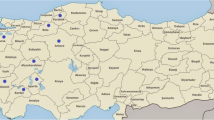Abstract
Most parts of Germany are iodine deficiency areas. Daily iodine intake may be increased by food with high iodine content. Therefore determination of iodine in different foodstuffs is of importance. Aim of our work was to develop a method for mineral waters. Besides, we wanted to find out to what extent natural mineral waters can contribute to the iodine supply of the population. The method is based on the reaction of the halogenids iodide and bromide with ethylene oxide in a sulfuric acid medium while converting into 2-iodo- and 2-bromoethanol. After extraction, the reaction products are determined by capillary gas chromatography with an electron capture detector. The method was modified for mineral waters. Single results were confirmed by ICP-MS. For mineral waters the limits of determination are 3 μg/L for iodide and 42 μg/L for bromide. The investigation of mineral waters from Hessen showed, that only few sources contain iodide in remarkable amounts. Therefore a considerable improvement of iodide intake is possible only with single mineral waters.
Similar content being viewed by others
Literatur
Zietz B, Brückner N (1994) Akt Ernähr Med 19: 12–17
Gladtke E (1977) Spurenelemente. Thieme, Stuttgart
Manz F (1991) Ernähmngs-Umschau 38: 234–238
Belitz HD, Grosch W (1987) Lehrbuch der Lebensmittelchemie. Springer, Berlin Heidelberg New York
Mutschler E (1976) Arzneimittelwirkungen. Wissenschaftl Verlagsgesellschaft mbH, Stuttgart
Deutsche Einheitsverfahren zur Wasser-, Abwasser- und Schlammuntersuchung D3 (1979) Bestimmung des Iodid-Ions. VCH, Weinheim
Deutsche Einheitsverfahren zur Wasser-, Abwasser- und Schlammuntersuchung D22 (1994) Vom Wasser Band 82
Schramel P, Hasse S (1994) Mikrochim Acta 116: 205–209
Bakker HJ (1977) J Assoc Off Anal Chem 60: 1307–1309
Stijve T (1981) Dtsch Lebensm Rundsch 77: 99–101
Grandet M, Weil L, Quentin K-E (1983) Z Wasser Abwasser Forsch 16 Nr. 2: 66–71
Eckes S, Didié I (1992) Lebensmittelchemie 46: 132
Allinger, Cava, de Jongh, Johnson (1980) Organische Chemie, de Gruyter, Berlin New York
Hollemann-Wiberg (1985) Lehrbuch der Anorganischen Chemie. de Gruyter, Berlin New York
DIN 32645 (1991) Chemische Analytik - Nachweis-, Erfassungsund Bestimmungsgrenze. Beuth, Berlin
Deutsche Forschungsgemeinschaft (1991) Methodensammlung zur Rückstandsanalytik von Pflanzenschutzmitteln, Abschnitt XI-A, 11. Lieferung, VCH, Weinheim
Lebensmittelrecht Textsammlung (1995) Beck'sche Verlagsbuchhandlung, München
Genossenschaft Deutscher Brunnen eG (1995) Der Mineralbrunnen 11: 449
Deutsche Gesellschaft für Ernährung (1991) Empfehlungen für die Nährstoffzufuhr, 5. Überarbeitung. Umschau, Frankfurt/Main
Author information
Authors and Affiliations
Rights and permissions
About this article
Cite this article
Kirchner, S., Stelz, A. & Muskat, E. Beitrag natürlicher Mineralwässer zur lodidversorgung der Bevölkerung. Z Lebensm Unters Forch 203, 311–315 (1996). https://doi.org/10.1007/BF01231067
Received:
Revised:
Issue Date:
DOI: https://doi.org/10.1007/BF01231067




